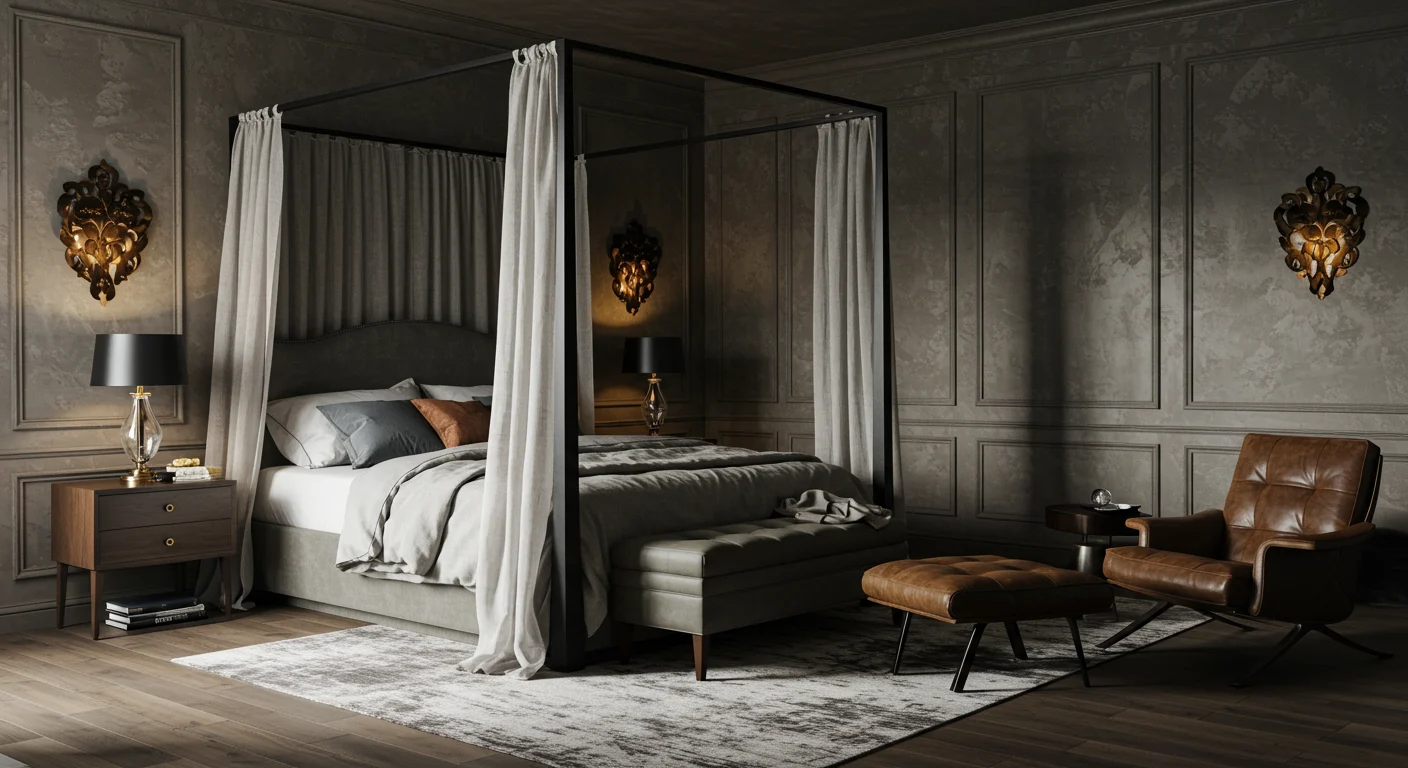So you love those dramatic, dark bedrooms you see in design magazines but you’re worried about creating something that feels more like sleeping in a basement than a sophisticated retreat. You’re not wrong to be cautious—moody bedrooms can easily tip from luxurious sanctuary into depressing cave if you don’t understand the fundamentals.
Here’s what most people get wrong about moody bedroom design: they think it’s just about painting everything black and adding some candles. But real moody bedroom style is about creating intentional drama through rich colors, luxurious textures, and lighting that makes you feel like you’re staying at an expensive boutique hotel every single night.
Whether you’re working with a master bedroom or trying to make a smaller space feel more sophisticated, these steps will help you create a moody bedroom that feels cocooning and luxurious rather than dark and depressing.
Understanding What Makes Moody Bedrooms Work
Before diving into the specifics, let’s talk about what separates stunning moody bedrooms from ones that just feel gloomy and unwelcoming.
Rich Colors, Not Just Dark Ones – Moody doesn’t mean black walls and calling it done. The best dark bedrooms use sophisticated, complex colors with depth and warmth.
Lighting Is Your Secret Weapon – Without proper lighting, dark bedrooms feel like caves. The right lighting creates atmosphere while providing function.
Luxury Is in the Details – In darker spaces, texture and quality become even more important since there’s nowhere to hide cheap materials or poor craftsmanship.
15 Steps to Perfect Moody Bedroom Style
Step 1: Start With a Deep, Rich Color Foundation
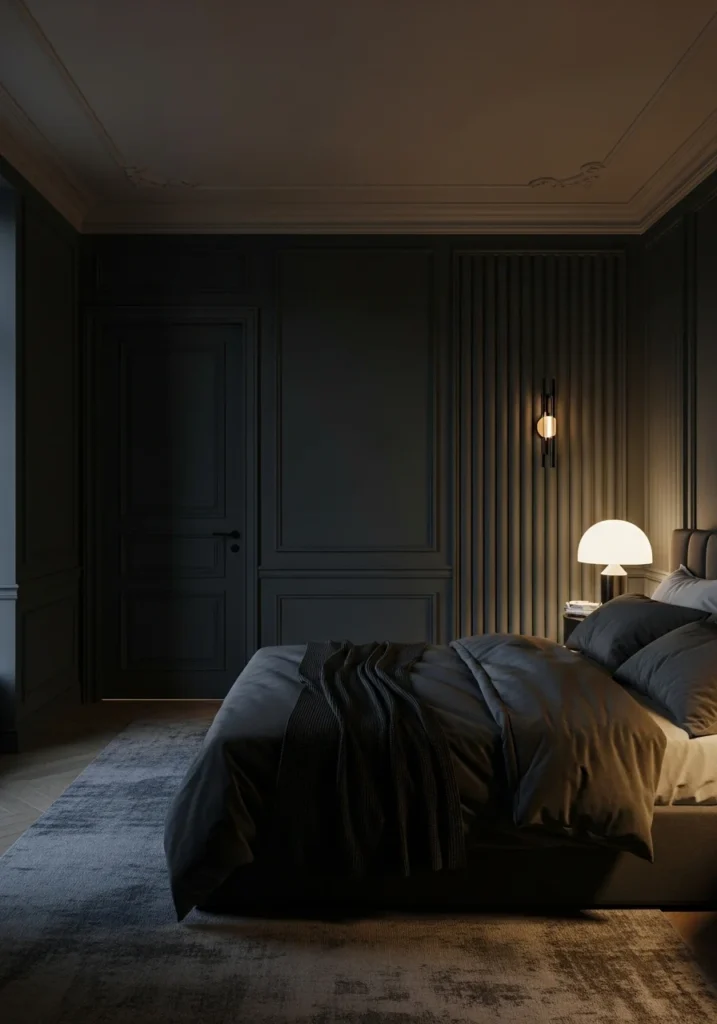
Begin with walls drenched in sophisticated dark hues—matte charcoal gray, midnight navy, or deep forest green using low-sheen finishes that absorb light for that cocooning effect. Pair with slightly lighter trim and ceiling tones to create depth rather than flatness.
Add architectural details like wall molding, paneling, or Venetian plaster to elevate the richness beyond basic paint. The goal is creating a sophisticated, enveloping foundation that instantly feels like a designer retreat rather than just a dark room.
Step 2: Layer Luxurious Textures Throughout
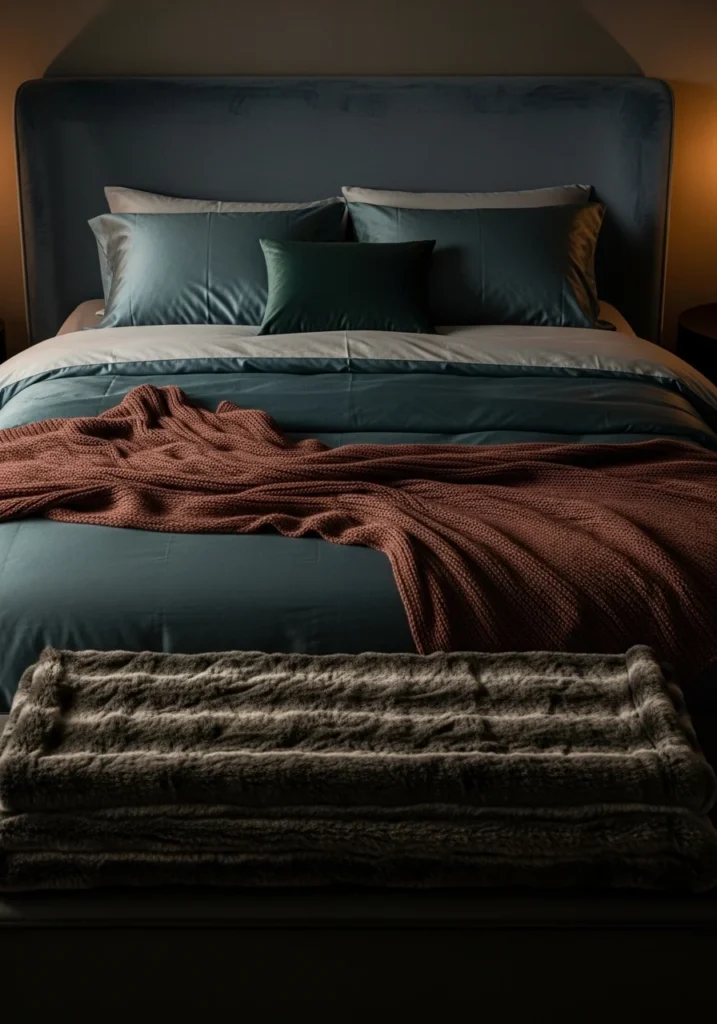
Combine velvet headboards, silk bedding, and high-thread-count cotton sheets for tactile richness. Layer chunky knitted throws, cashmere blankets, and suede accent pillows to add visual depth and comfort.
Use tonal jewel hues—muted emerald, oxblood, or sapphire—balanced with soft neutrals. Every texture should invite touch while maintaining harmony. This layering makes your bed the true centerpiece, radiating boutique-hotel luxury.
Step 3: Choose Low, Ambient Lighting That Flatters
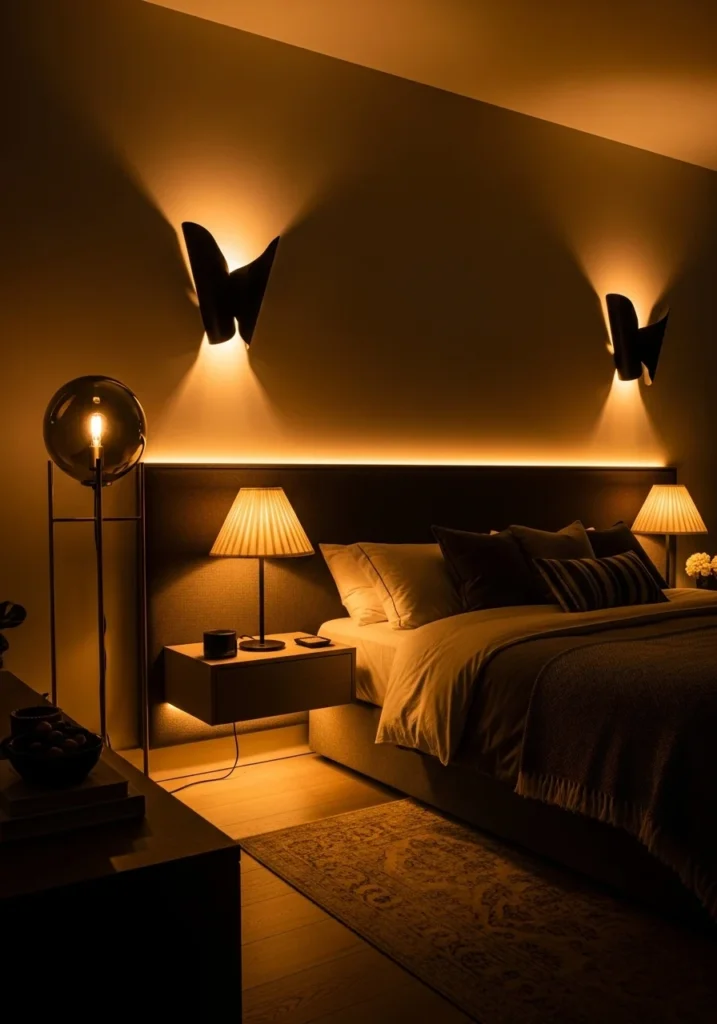
Skip harsh overhead fixtures and opt for warm, sculptural lighting that glows softly throughout the space. Use dimmable wall sconces in brushed brass, smoked-glass pendants hung low beside the bed, and tall designer floor lamps for reading.
Add hidden LED strips behind headboards or beneath floating nightstands for cinematic underglow. Keep all bulbs at 2700K for flattering amber warmth that makes the space feel indulgent and intimate rather than clinical.
Step 4: Create Drama With an Oversized Statement Headboard
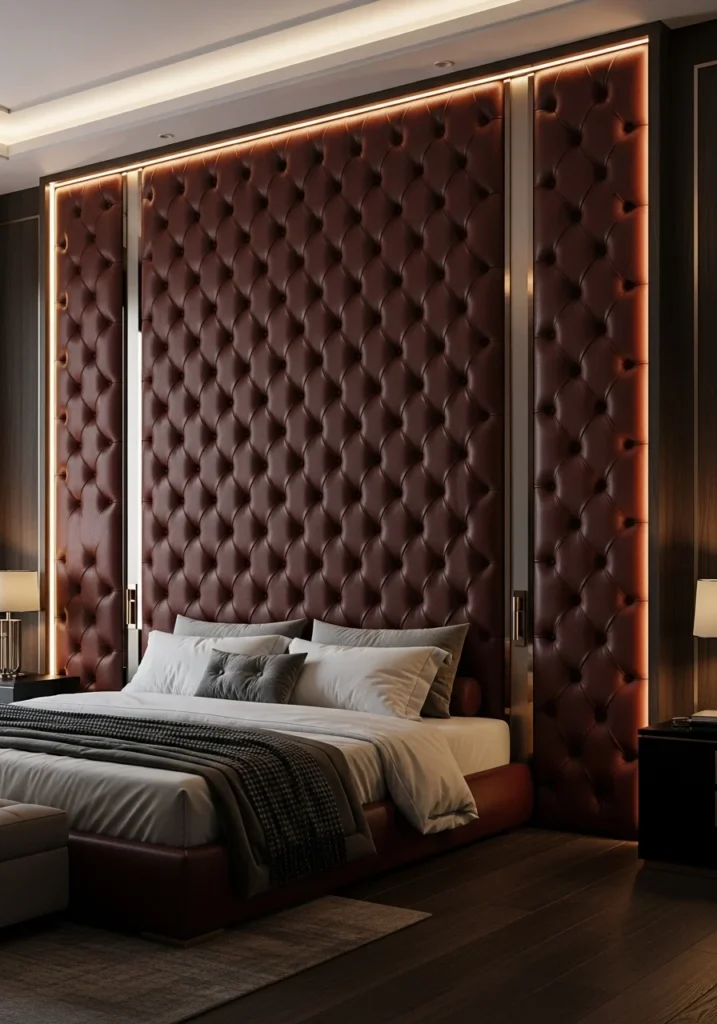
Anchor your bed with an upholstered headboard in velvet, suede, or tufted leather that commands attention. Consider extending it wall-to-wall for maximum drama and impact.
Choose rich tones like oxblood, navy, or espresso brown that dominate the space with sophistication. Frame the headboard with integrated lighting or slim metallic accents to make the bed your undeniable luxury focal point.
Step 5: Add Theatrical Drama Through Window Treatments
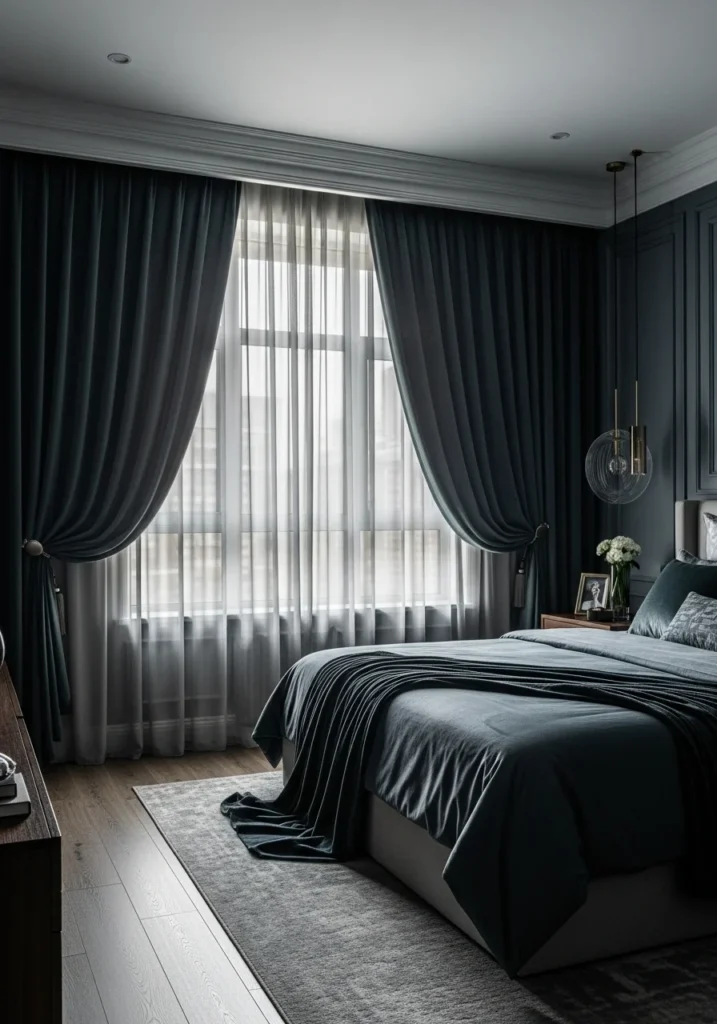
Install floor-to-ceiling drapes in heavy velvet, linen, or silk that give your bedroom its dramatic edge. Choose deep tones that pool slightly on the floor for opulence and hang them extra wide beyond window frames to exaggerate fullness.
Layer sheer curtains underneath to soften daylight while maintaining privacy. This creates theatrical, designer-level luxury that transforms ordinary windows into dramatic focal points.
Step 6: Break Up Darkness With Strategic Metallic Accents
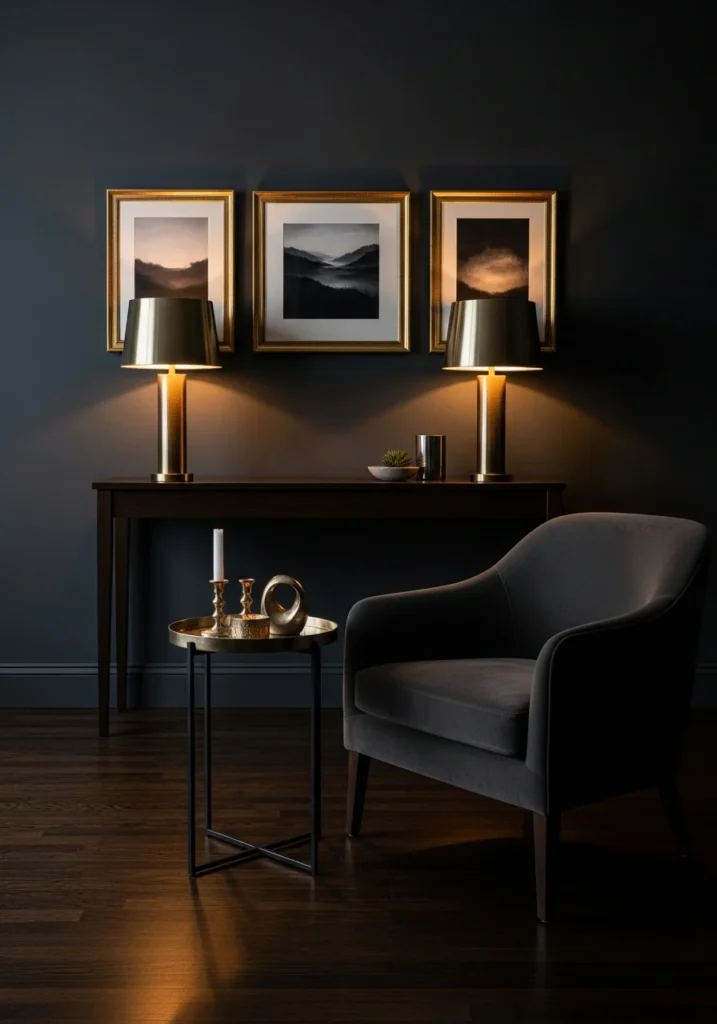
Use subtle metallic highlights that shimmer against your moody palette—brushed brass table lamps, antique gold picture frames, or blackened steel side tables. Incorporate metallic trays, candleholders, or sculptural objects for reflective intrigue.
Keep it restrained so these accents feel curated rather than overwhelming. The contrast injects quiet glamour while preventing the space from feeling too heavy or monotonous.
Also Read: 15 Bathroom Mirror Ideas That Make Your Daily Routine Feel Like a Spa Experience
Step 7: Ground the Space With a Luxurious Rug
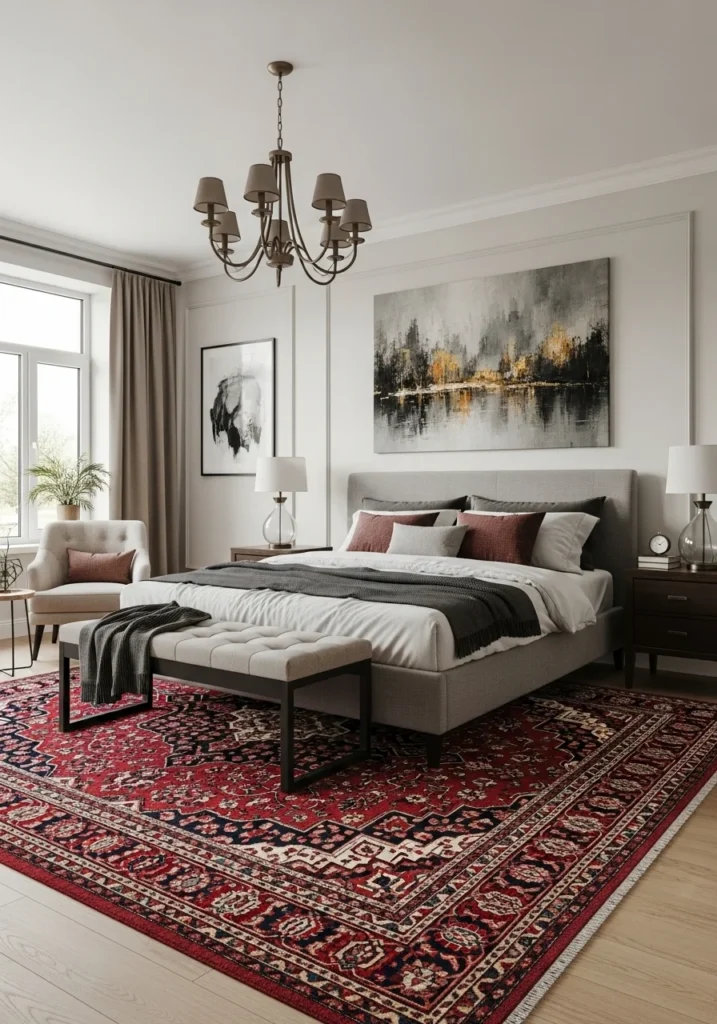
Use a large, plush rug in deep tones—Persian rugs with rich reds, handwoven wool with intricate patterns, or thick shag rugs in charcoal. Place it beneath the bed extending generously on all sides for warmth and acoustical softness.
A quality rug ties together all your layers while anchoring furniture in a designer way that makes the whole room feel more expensive and intentional.
Step 8: Add Natural Elements to Prevent Coldness
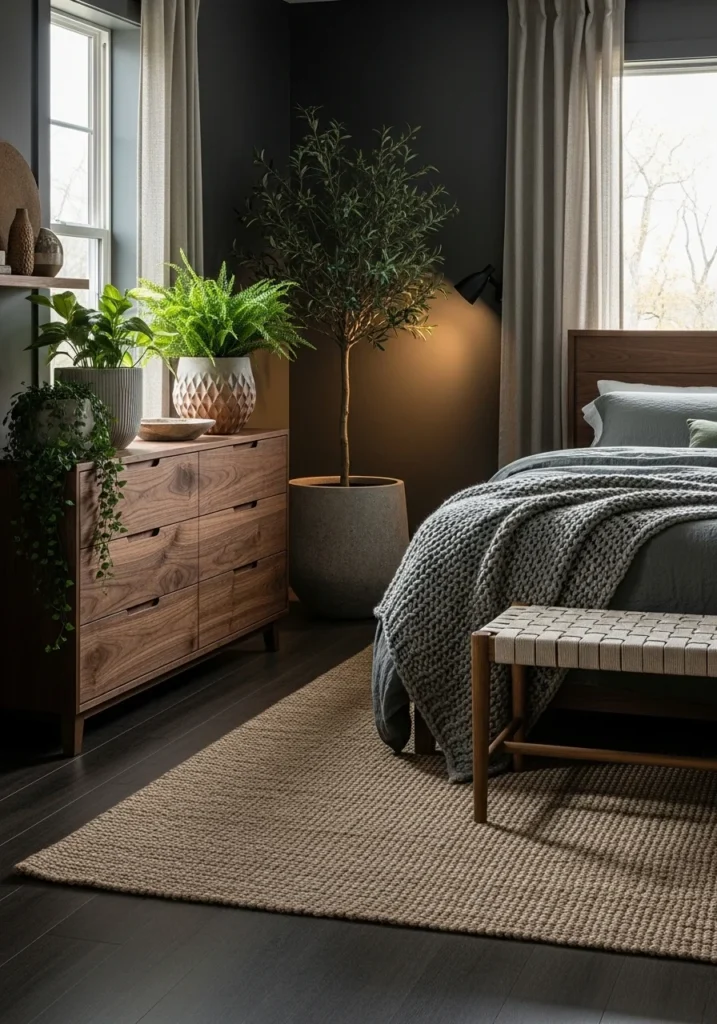
Balance the heaviness of dark colors with natural materials—dark walnut or espresso-stained furniture, potted greenery in oversized planters, or woven linen benches. A single olive tree in a corner under soft light adds organic elegance.
Natural elements prevent the space from feeling too cold or artificial, bringing grounding warmth that harmonizes with darker tones.
Step 9: Install Sculptural Lighting as Functional Art
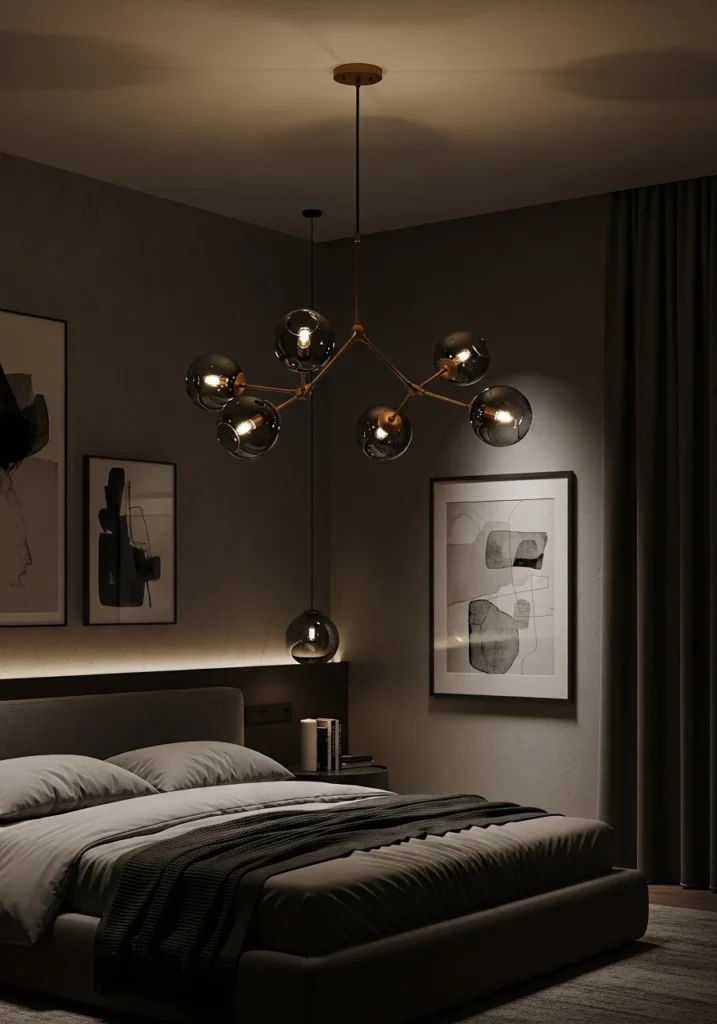
Add drama with statement chandeliers or pendants in sculptural forms—smoky-glass globe chandeliers, linear brass fixtures, or asymmetrical blackened metal designs. Hang fixtures lower to create intimacy rather than flooding the space with light.
Sculptural lighting acts as functional art, giving your room modern, gallery-like refinement that feels intentional and expensive.
Step 10: Use Mirrors to Add Balance and Reflect Light
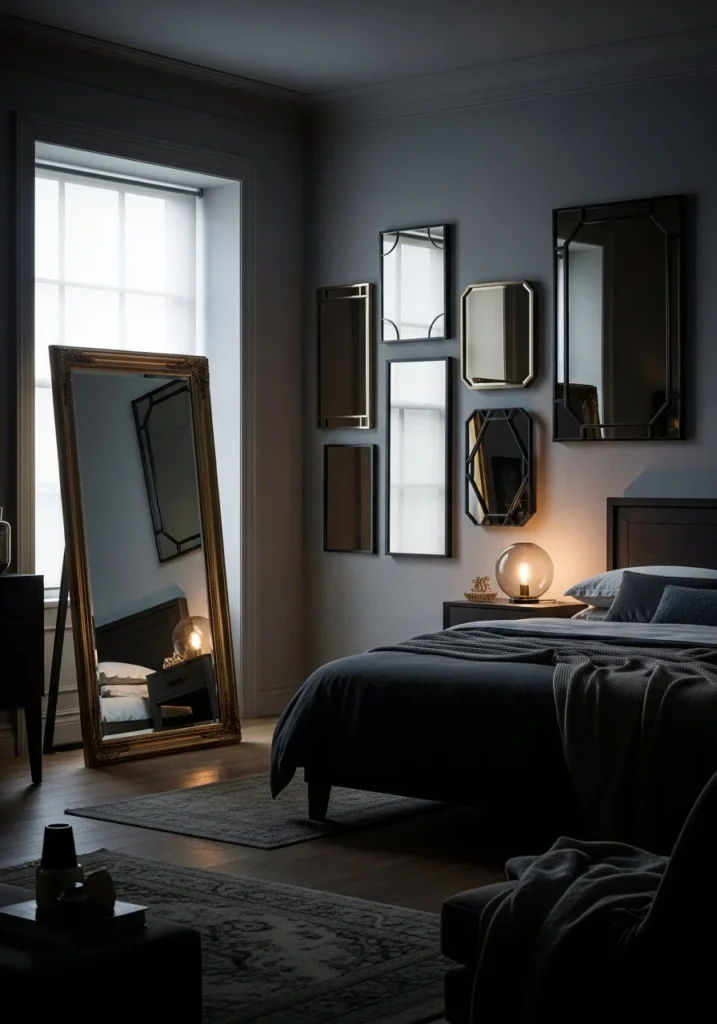
Expand the space and reflect soft light with large framed mirrors in antique gold, smoked glass, or blackened steel frames that coordinate with your palette.
Full-length leaning mirrors add elegance while grouped smaller mirrors feel curated and intentional. These reflective surfaces bring visual balance without disrupting your moody aesthetic.
Step 11: Choose Low, Grounded Furniture for Intimacy
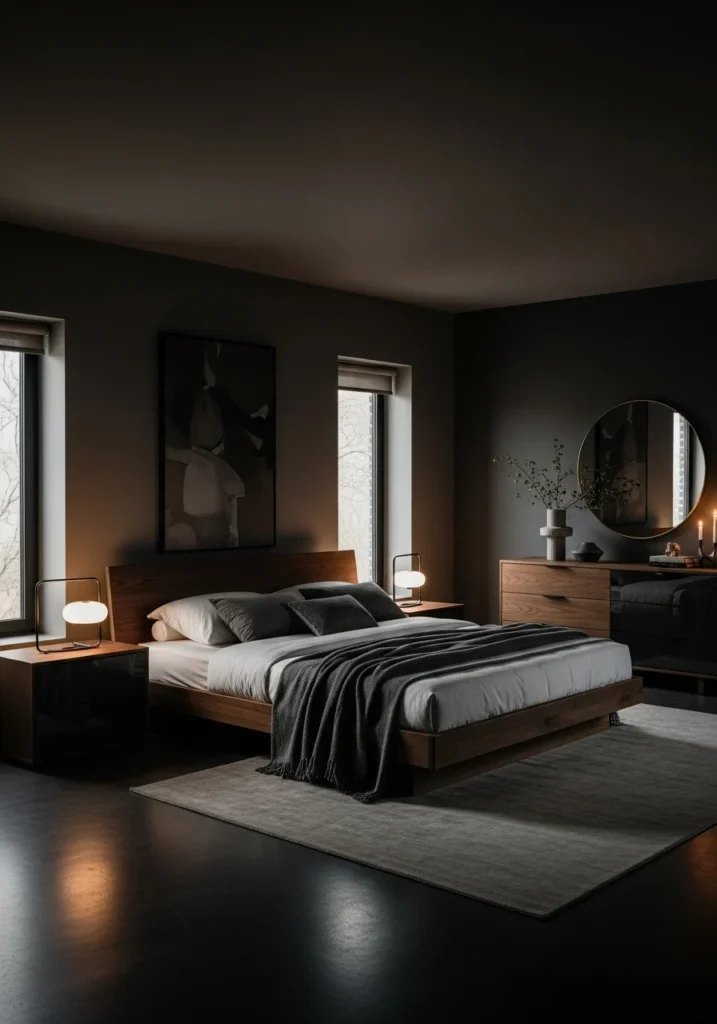
Select low-profile, streamlined furniture that enhances the cocoon-like feeling—sleek platform beds, minimalist nightstands, and clean-lined dressers in rich wood or lacquer finishes.
Avoid overly ornate pieces and focus on designer silhouettes with luxurious materials. Low furniture heightens the intimate mood while creating sophisticated visual proportions.
Step 12: Accessorize With Intentional Restraint
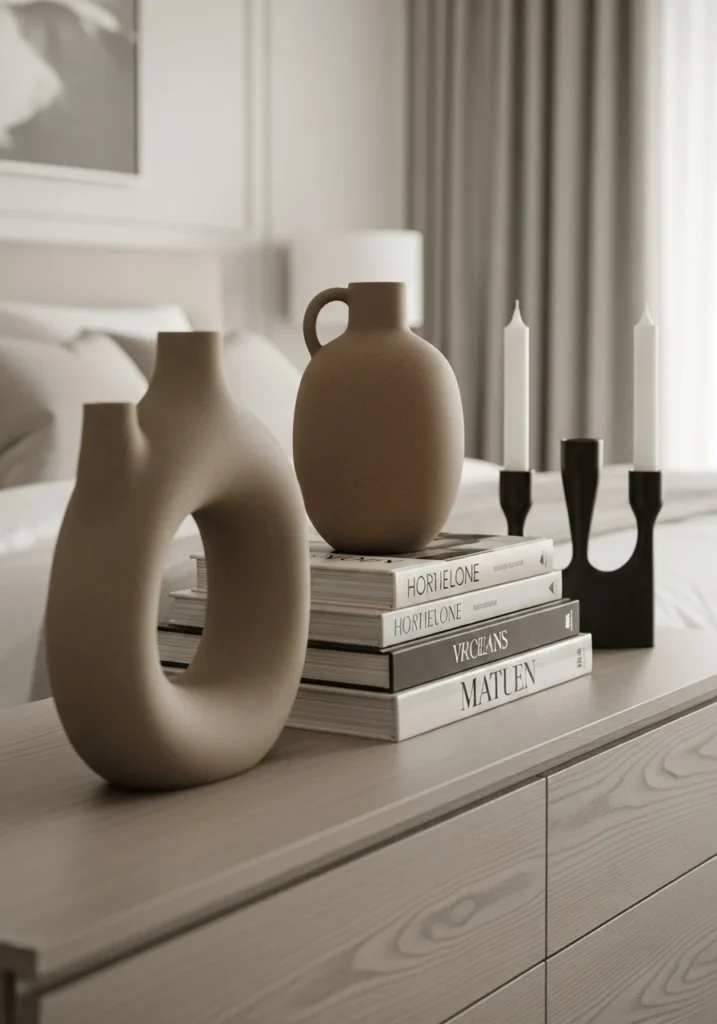
Curate a few impactful objects rather than cluttering surfaces—a matte ceramic vase, stacked designer books, or a sculptural candleholder. Group accents in odd numbers and vary heights for visual balance.
Keep surfaces minimal to highlight your beautiful materials and textures. This restraint ensures the bedroom feels curated and luxurious like a styled editorial rather than over-decorated.
Step 13: Perfect Your Layered Bedding Strategy
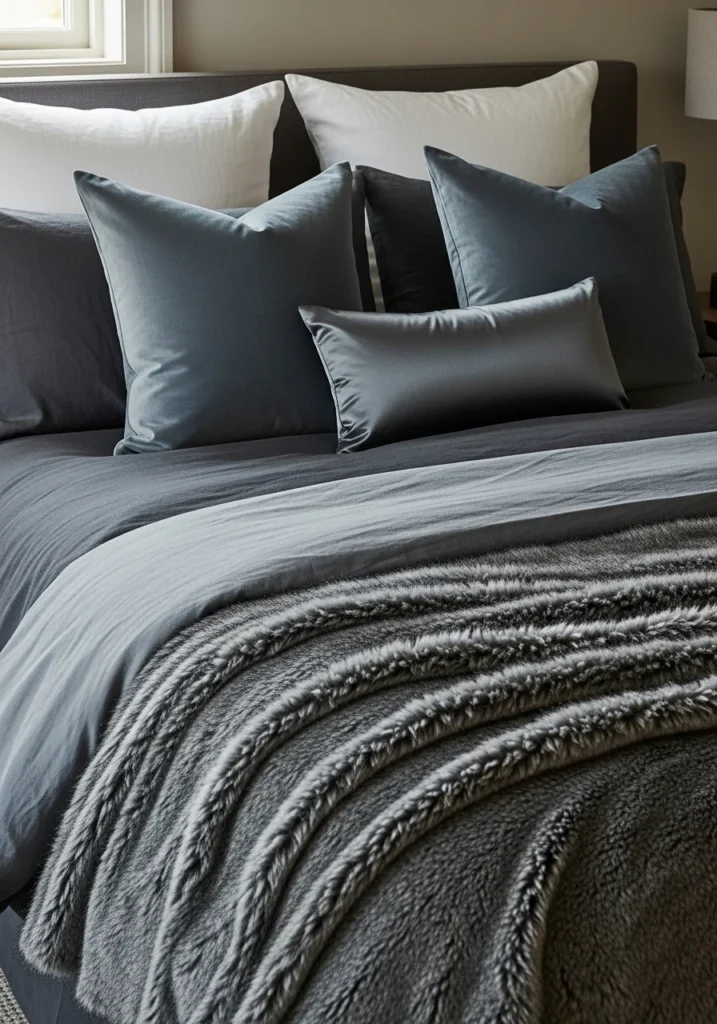
Use tonal layering instead of busy patterns for sophisticated bedding. Start with dark sheets, add a slightly lighter duvet, and top with textured throws in velvet, wool, or faux fur.
Stick to 2-3 shades within the same color family for cohesion. Layer pillows with different fabrics—linen, velvet, silk—to create dimension. The bed should look indulgent yet effortlessly styled.
Step 14: Include an Unexpected Element of Surprise
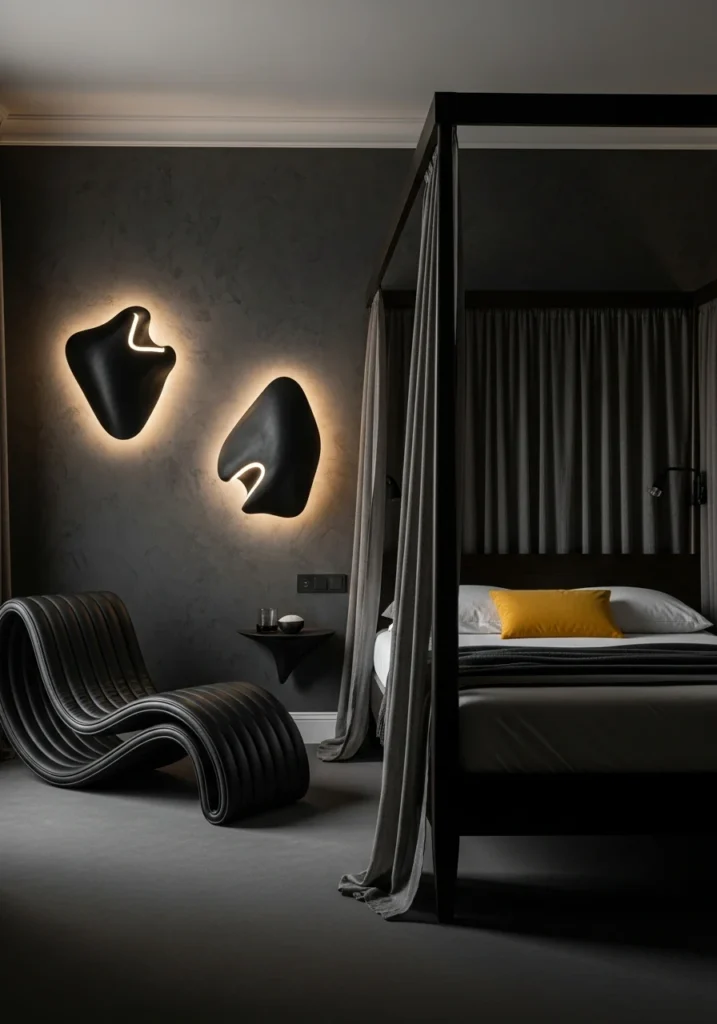
Every successful moody bedroom needs a wow factor that feels unexpected and prevents the space from being predictable. Consider a Venetian plaster accent wall, canopy bed with sheer draping, or sculptural leather lounge chair.
Add dramatic wall sconces shaped like art pieces or introduce a bold color pop through a single accessory. This surprise element gives your room a signature designer touch that makes it memorable.
Making Moody Work for Real Life
The biggest challenge with moody bedrooms is ensuring they remain functional and welcoming for daily use. Consider blackout capabilities for better sleep, adequate task lighting for reading, and storage solutions that maintain the clean aesthetic.
Think about your climate too—dark colors can make rooms feel warmer, so ensure proper ventilation and temperature control. In smaller spaces, use mirrors and lighter accents more generously to prevent the room from feeling cramped.
Avoiding the Goth Cave Look
The difference between sophisticated moody bedrooms and spaces that feel depressing usually comes down to lighting quality, texture variety, and maintaining some visual relief. Never rely on just one light source, always include multiple textures to create richness, and use metallic accents or mirrors to add brightness.
The goal is creating drama and intimacy while maintaining luxury and comfort. When your bedroom makes you feel like you’re staying somewhere special every night, you’ve nailed the moody aesthetic.
Final Thoughts
Creating a moody bedroom that feels luxurious rather than depressing requires understanding that darkness is just one tool in your design arsenal. The best moody bedrooms use rich colors, quality materials, and thoughtful lighting to create spaces that feel both dramatic and welcoming.
When your bedroom becomes your favorite room in the house—the place you look forward to retreating to—you’ll know you’ve successfully created that sophisticated moody atmosphere that makes everyday life feel more luxurious.

